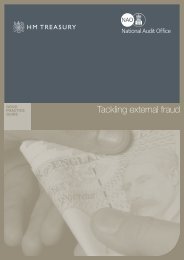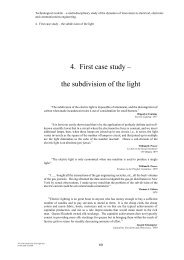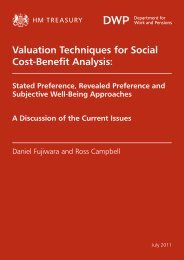Valuing Our Natural Environment Final Report ... - HM Treasury
Valuing Our Natural Environment Final Report ... - HM Treasury
Valuing Our Natural Environment Final Report ... - HM Treasury
You also want an ePaper? Increase the reach of your titles
YUMPU automatically turns print PDFs into web optimized ePapers that Google loves.
<strong>Valuing</strong> <strong>Our</strong> <strong>Natural</strong> <strong>Environment</strong> – <strong>Final</strong> <strong>Report</strong> - Annex1<br />
the recreational value of that site. A common response may be to weight cost according to<br />
the proportion of the day’s ‘enjoyment’ to the site in question, although how this is carried<br />
out with likely influence estimates of consumer surplus.<br />
In addition, the inclusion of different factors in the travel cost calculation will also likely<br />
result in different estimates of consumer surplus. Specifically, expenditure on travel may<br />
be estimated in terms of marginal cost (e.g. petrol costs only), full costs (e.g. petrol costs,<br />
insurance, maintenance costs, etc.) or perceived costs as estimated by survey respondents.<br />
Notably, the second formulation will lead to higher estimated costs than the first. Aside<br />
from derivation of travel costs, the way in which the cost of time spent travelling is dealt<br />
with may also lead to different estimates of recreational value. For example, omitting time<br />
costs will ensure that consumer surplus is under-estimated; however, there is no definitive<br />
assessment as to how the value of time should be accounted for. The wage rate approach<br />
sets time costs as some proportion of the visitor’s wage rate. Typically, this will be less<br />
than 100 percent to reflect the fact that most individuals are not completely free to tradeoff<br />
between leisure and work time. Arguably, assumptions concerning the value of time are<br />
largely subjective, and therefore sensitivity of consumer surplus estimates to the value of<br />
time is a key issue in the application of the TCM.<br />
A further issue to consider is the presence of substitute sites. Generally, alternative sites<br />
will depress demand below ‘true’ demand’ and failure to account for this may lead to an<br />
under-estimate of the recreational value of a given site. In particular, if there are several<br />
similar sites within a similar distance, then the demand for each site will be less than<br />
demand for the recreation experience. Alternative sites can be incorporated into analysis<br />
(in the trip-generating function) through specific questions to respondents in survey and GIS<br />
techniques can also be applied to generate data (Brainard et al., 1999), such as distance<br />
between sites.<br />
In addition to the affect of substitute sites, it is also difficult for the TCM to capture fully<br />
the effects of variation in quality of sites and also individual characteristics of sites and<br />
how these influence the demand for visits to a site. In particular, an improvement in site<br />
quality should raise demand for the visits to the site at every level of travel cost.<br />
Accordingly the difference between the original demand curve and the new demand curve<br />
represents the change in consumer surplus. However, there is also the need to account for<br />
changes in other sites and the substitution of visits from one site to another which arise<br />
from improved quality as well as the impact on travel costs which this will have (Freeman,<br />
1993). While the TCM is suited to explaining recreation demand over a given time period<br />
(e.g. the number of visits in a year), it is not suited to considering these effects. Instead,<br />
random utility models (RUM), which are an extension to the standard TCM, are however<br />
suited to the consideration of the effects of the availability of substitute sites and changes<br />
in quality levels of specific site characteristics (Bockstael et al., 1991; Freeman, 1993) (see<br />
separate RUM fiche for further discussion).<br />
A distinct issue concerning practical TCM applications is a lack of theoretical guidance,<br />
concerning the appropriate functional form of the trip-generating function. Moreover,<br />
different studies often use different functional forms. It is often observed that, for a single<br />
dataset, changing the functional form can result in different estimates of consumer surplus<br />
without resulting in significant differences in the statistical fit of different models (see for<br />
example Hanley, 1989). Hence, appropriate specification of functional form is typically a<br />
matter of expert judgement and consequently a potential weakness of the TCM.<br />
<strong>Final</strong>ly, there is also consideration of the comparison between ITCM and ZTCM approaches.<br />
However this is not a straightforward issue, particularly in terms of the degree of<br />
explanation of a given dataset provided by each approach. In most instances, a higher<br />
degree of fit is found via the ZTCM, as observed in terms of the r-squared statistic. While<br />
the ITCM estimates the demand relationship by drawing on all observations and their<br />
variation, the ZTCM amalgamates travel cost into distinct bands, and consequently<br />
estimates demand from a smaller number of observations. Differences in r-squared<br />
statistics are therefore likely to be symptomatic of these differing approaches to estimating<br />
demand. Given this, it is not appropriate to compare these models on the basis of this<br />
eftec A14<br />
December 2006





![AIRTO [Professor Dr Brian Blunden] - HM Treasury](https://img.yumpu.com/15492848/1/184x260/airto-professor-dr-brian-blunden-hm-treasury.jpg?quality=85)










